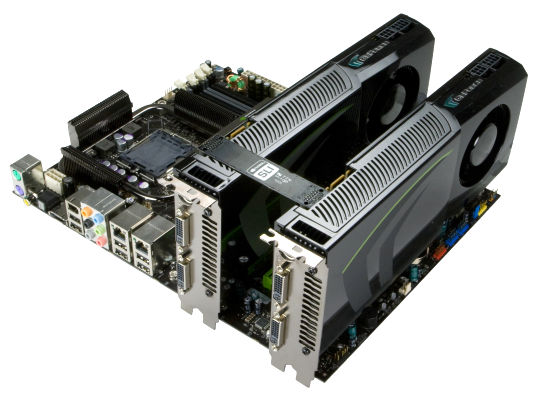NVIDIA PhysX
Realistic physical interactions play an important role in modern games, they make them more interesting. Almost all physical computations have high performance requirements, such algorithms require much computing. Only processors were responsible for these computations at first. Then there appeared physics accelerators from Ageia - they did not become very popular, but they still stirred up this market.
GPU manufacturers came down to the problem of physics computing on a GPU. But they initially worked with Havok, which was bought by Intel. Later on NVIDIA had to buy Ageia. It could offer PhysX SDK, which was more interesting than physical accelerators, their role is given to graphics cards now.
So, NVIDIA PhysX is a powerful real-time physics engine, which is used in many games for PCs and game consoles. The list of games with PhysX support contains over 150 items, which have been released or are developed for several platforms: PC, Sony Playstation 3, Microsoft Xbox 360, and Nintendo Wii.
PhysX API initially used CPUs and special physics accelerators from Ageia. But when it was ported to CUDA, such computations are accelerated by any graphics card from NVIDIA supporting CUDA. That is, starting from GeForce 8 up to the latest GeForce GTX 260 and 280. In other words, all 70 million graphics cards (GeForce 8 and 9) will soon get PhysX support, including some old projects.
PhysX in cooperation with a powerful GPU can offer a lot of new effects, such as: dynamic smoke and dust, cloth/liquid/gas simulations, weather effects, etc. Theoretically, CPUs can compute all these effects as well. What do gamers gain from delegating physics to GPUs? NVIDIA publishes the following diagram with relative performance results of the most popular physics algorithms in PhysX.
These tasks simulate cloth, particles, liquids, and soft bodies. On the average, this GPU is 11 times as fast as a quad-core CPU, even if not the fastest model. Not bad, if GPU-assisted physics computing does not decrease overall performance when it's limited by a graphics card.
Improved power management technology
Power management of the new graphics processor is improved relative to the previous generation of NVIDIA GPUs. It dynamically changes frequencies and voltages of GPU units depending on their load. It can also disable some of these units. As a result, GT200 consumes much less power in idle mode, about 25 W, which is very low for such a GPU. This solution supports four modes:
- Idle or 2D (about 25 W)
- HD/DVD video (about 35 W)
- Sterling 3D mode (up to 236 W)
- HybridPower mode (about 0 W)
GT200 uses special units that analyze data streams inside its GPU to evaluate its load. Relying on these data, the driver dynamically chooses a proper performance mode, sets the frequency and voltage. It optimizes power consumption and heat release of the card.
Some of idle GPU units can be disabled, which contributes much to energy efficiency. It all provides almost a 10-fold difference in power consumption between Idle and 3D modes (25 W versus 236 W correspondingly).
We already reviewed HybridPower technology. This technology allows to disable a GPU in the GeForce GTX 280, if you use a motherboard with integrated graphics on the nForce chipset supporting this feature (for example, nForce 780a and nForce 790i). And when you start a 3D application, the driver switches from the integrated graphics core to a discrete graphics card.
Miscellaneous
NVIDIA SLI is supported, of course. GeForce GTX 280 supports both the usual SLI mode with two graphics cards, which boosts performance by 50-80%, and so-called 3-way SLI, which is still faster. This mode allows to use the highest resolutions and maximum graphics quality settings in all applications. This feature requires a proper motherboard based on nForce chipset, of course. To support these features, each graphics card has two SLI connectors, which can be used to connect the cards with a special bridge.
We always remind our readers of drawbacks of multi-GPU AFR mode. AFR raises FPS, but it cannot cope with latencies - rendering seems smoother than on a single-GPU system, but it's almost just as inconvenient to play as with a single graphics card.
Like all G9x-based cards, GeForce GTX 280 supports the second generation of PureVideo HD, which is also supported by GeForces 8 and 9. The following features are supported: hardware-assisted decoding of H.264, VC-1, and MPEG2 video, improved post processing, dynamic adjustment of contrast and hue, dual-thread HD video decoding, simultaneous operation of Windows Vista Aero and HD video decoding.
Reference GeForce GTX 260 and 280 cards come with two Dual Link DVIs with HDCP support and one HDTV-Out. HDMI and DisplayPort connectors can be replaced with adapters from DVI to HDMI or DisplayPort. There may also appear graphics cards from NVIDIA partners with corresponding connectors.
We've covered theoretical features of the GeForce GTX 200, based on GT200, which represents the second generation of the unified architecture from NVIDIA. The next part of this review will analyze synthetic tests to evaluate performance changes caused by architectural improvements and determine weaknesses and fortes of the graphics cards. We'll also find out how this new top card performs relative to other models.
Write a comment below. No registration needed!


